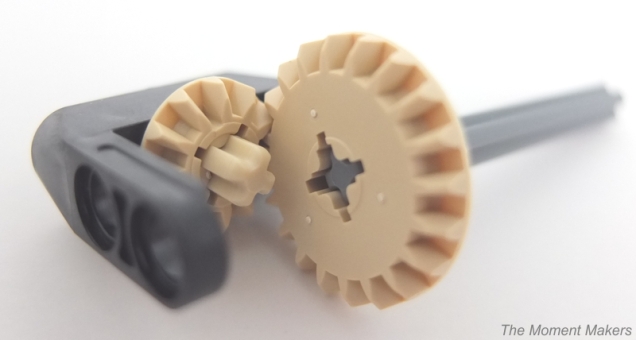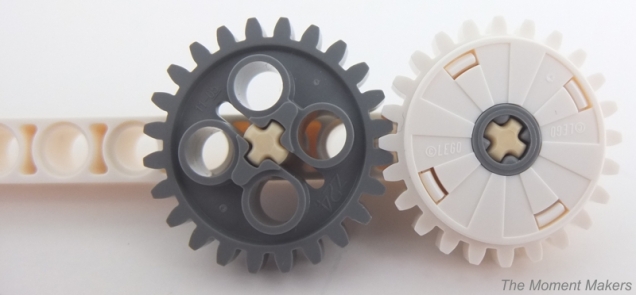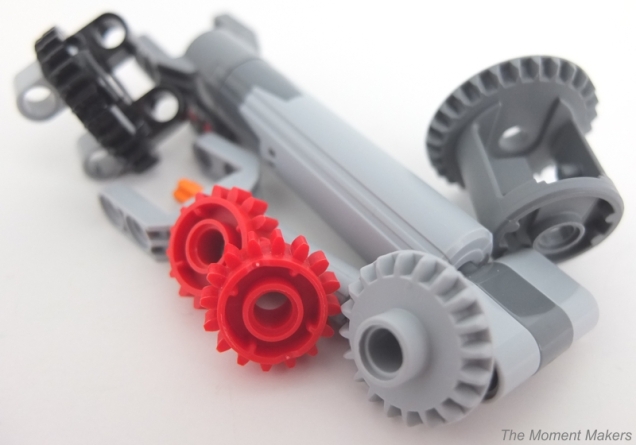
Gears are everywhere, from seemingly simple toys to as complex things as cars. We think that it is amazing that LEGO Technic has incorporated so many gears into their sets to create functioning machines or robots to be used in FLL (FIRST LEGO League). In addition, many other LEGO themes such as City and Friends have used gears for many of their special functions. In this article, we will show you the types of gears as well as their uses.
Gear Train Terminology
Before reading this article, it is important to understand some basic terms for the gears. A gear train is at least two gears connected to one another through their teeth. The gear at the beginning of the gear train is called the driver gear. This is the gear that turns all the other gears in the train. The last gear in the gear train is called the follower gear. This is the gear is responsible for applying the force generated by the driver gear to its axle. One important difference between driver gears and follower gears is that driver gears are turned by the axle in their center which then turns its teeth, but follower gears are turned by their teeth which then turns its axle. This axle can then be used to turn a lever or another gear train. Some gear trains include idler gears, which pass on the motion from the driver gear to the follower gear over greater distances. They can also be used to change the motion of the follower gear in relation the driver gear. Remember, gears always turn towards each other, which means that in a two-gear gear train, if the driver gear is turning clockwise, then the follower gear is turning counter-clockwise. There is no limit to how many idler gears can be in a gear train, but there can be only one driver gear and only one follower gear.
Main Types of Gears
In LEGO, there are three types of gears that are used in almost every Technic set: regular, single bevel, and double bevel. These gears can be used for making arms move in a swing like motion (rotating around one central point). We will take a dive into what these gears are and some of their uses.

LEGO’s regular gear type is very common and comes in four sizes: 40 tooth (light gray), 24 tooth (dark gray), 16 tooth (light gray), and 8 tooth (dark gray).

Unlike the beveled gears, these gears can only connect on one plane (next to each other). For some examples of LEGO set applications, check out Amusement Park Bumper Cars, Rebel Combat Frigate, Cherry Picker, and Extreme Adventure.

The single bevel gears are not as commonly used in LEGO sets, but can be useful for their half-beam width. These gears come in two sizes: 20 tooth and 12 tooth (both tan).

These gears only have teeth on one side, meaning that they cannot connect on the same plane. Instead, these gears connect perpendicular to one another. A pair of gears connected in such a way is said to be transverse. For some LEGO set application of these gears, check out Gorzan’s Gorilla Striker and Extreme Adventure.

Double bevel gears are perhaps the most common type of gear due to their many uses. These gears come in four sizes: 36 tooth (black), 20 tooth (light gray or tan), 12 tooth (black), and the new 28 tooth (light gray) which was just released with LEGO set 10269 Harley-Davidson Fat Boy.

Double bevel gears have features of both other types of gears because double bevel gears can connect on the same plane or transversely. We demonstrate two of the possible ways these gears can be transversely connected below. These gears also have stronger teeth than the others above because they are reinforced. Because of their stronger teeth, double bevel gears can oftentimes be a better choice to use than the regular gears, if a gear train will be under a lot of stress. A double bevel gear’s strength is also why it is preferred to a single bevel, and why single bevel gears are not used as frequently.

For some LEGO set applications of these gears, check out Container Yard Part 1, Extreme Adventure, Roadwork Crew Part 1, and Ultralight Helicopter.
Gear Racks and Worm Gears
When you think of gears, you usually picture gears looking more like the ones in the section above. In this section, we will talk about two very different types of gears that can be extremely useful.

Gear racks (or just racks) are basically long, flat gears. Racks are mainly used for pushing things side to side. They can be turned by regular, double bevel and worm gears. Especially when reinforced by a worm gear, racks can be extremely useful. Racks come in three main sizes: 8 tooth (black), 22 tooth (black), and a 32 tooth (dark gray) with housing (light gray or red). In addition, special 35 tooth curved racks (yellow or black) can be used to push things up and to the side or to create large turn table by attaching four together.

There are also 10 tooth rack segments (black, dark gray, light gray, or white) that can be attached to regular LEGO plates to customize rack length. For some LEGO applications of these gear racks, check out Container Yard Part 1 and Extreme Adventure.
Racks are mainly used for pushing things side to side or up and down. They can be turned by regular, double bevel and worm gears.

Worm gears are corkscrew shaped. Though they connect to regular, double bevel, and racks, they cannot connect on the same plane. Using worm gears in a gear train will let the gears pick up more weight at the cost of being much slower. For some LEGO set applications of these gears, check out Cherry Picker and Roadwork Crew Part 1.
Other Types

Another very useful gear is the clutch gear or “slip gear.” The 24 tooth (white) gear is very similar to the dark gray regular gear (same size and outer shape). The difference is that, under stress, the inside of the gear can turn without the outside (the teeth) turning. This can be helpful when a motor has moved too far because it prevents gears from slipping, therefore preventing tooth damage. However, these gears are not useful as idler gears and should only be used as driver or follower gears in a gear train.

The “knob gear” is a 4 tooth (yellow or black) gear that is used in many sets. These gears can connect both on the same plane or transversely. We demonstrate this with the two separate gear trains above. Unlike all of the other gears, these have a different sized tooth. For some LEGO set applications of these gears, check out Ninjacopter and Rebel Combat Frigate.

Although we can’t talk about them all in this article, we plan on describing all the other types of gears.
We put together a list of LEGO part numbers of all the gears described in this article.
| Gear Type | Tooth Count | LEGO Item # |
|---|---|---|
| Regular Gear | 8 teeth | 10928 |
| Regular Gear | 16 teeth | 94925 |
| Regular Gear | 24 teeth | 3648 |
| Regular Gear | 40 teeth | 3649 |
| Single Bevel | 12 teeth |
6589
|
| Single Bevel | 20 teeth | 32198 |
| Double Bevel | 12 teeth | 32270 |
| Double Bevel | 20 teeth | 18575 |
| Double Bevel | 28 teeth | 46372 |
| Double Bevel | 36 teeth | 32498 |
| Gear Rack | 8 teeth | 87761 |
| Gear Rack | 22 teeth | 64781 |
| Gear Rack | 32 teeth | 18942 (housing 18940) |
| Gear Rack (curved) | 35 teeth | 24121 |
| Gear Rack (buildable) | 10 teeth | 3743 |
| Worm Gear (light gray) | corkscrew shaped | 32905 |
| Worm Gear (dark gray) | corkscrew shaped | 27938 |
| Clutch Gear | 24 teeth | 76244 |
| Knob Gear | 4 “teeth” (not standard size) | 32072 |
We hope you enjoyed reading this article! To learn more about gears, you can also read our article on gear trains.

One thought on “Gears: Types of Gears”
Comments are closed.